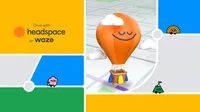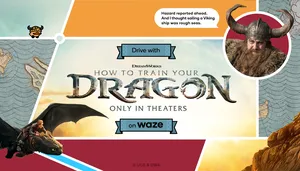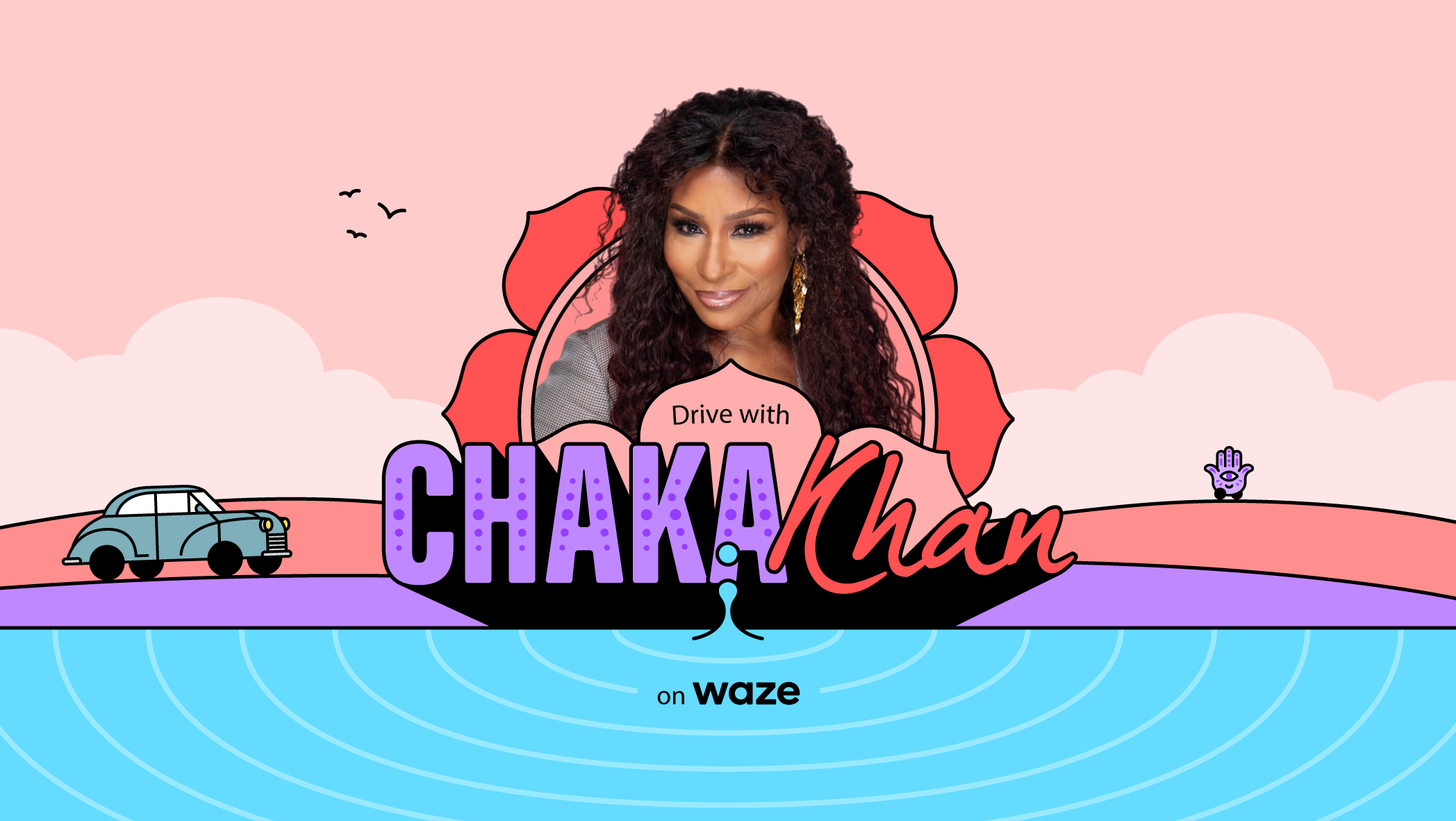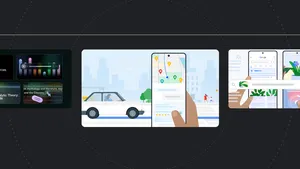Welcome a new era of happier driving with Headspace

Traffic is the worst. The longer you’re in it, the worse your blood pressure, sleep, back pain, and risk of depression. As more and more people get back into the rhythm of having to commute to school or work, many are finding themselves stuck in traffic again. To find a way to help combat the negative effects of traffic and encourage drivers to enjoy their drives, we turned to our friends at Headspace, a global leader in mindfulness and mediation.
We’re combining our mission to eliminate traffic with Headspace’s aim to improve the health and happiness of the world with a Headspace experience on Waze. Designed to help drivers learn how to find more joy and meaning on the road, this theme offers custom navigation prompts from Headspace’s mindfulness teacher and Director of Meditation, Eve Lewis Prieto.
To put you in the right mindset to take on the roads, the Headspace experience on Waze also includes a selection of 5 moods — Aware, Bright, Hopeful, Joyful, and Open — and the ability to swap out the in-app car icon for a serene ride in a hot air balloon. Drivers can choose to stream a custom Spotify playlist with music and content from Headspace, which is also available via the Waze Audio Player.
We spoke to Eve herself to find out how we can take better care of our mental wellbeing both on and off the road.
***
Hi Eve! We’re so excited to meet the person behind one of Headspace’s most recognizable voices. Can you tell us what being mindful means to you?
Well thank-you, this is a really exciting partnership, more aware drivers on the road can only be a good thing! Before I answer this question, I think it is helpful to unpack the word mindful or mindfulness: a term that folks may have heard a lot before. Mindfulness or being mindful is really a quality of being in the present moment, intentionally resting your attention and your awareness with or on whatever it is you are doing with a sense of curiosity, openness and kindness. We spend so much of our time caught up or distracted by our thoughts, feelings and emotions that we miss so much of what is happening right in front of us. Practicing mindfulness helps us to live IN each moment regardless of what is arising, that way we start to learn how to slow down and to nurture a sense of calm and ease in the mind and body.
So for me, being mindful is really trying to intentionally be IN each moment. If I am cooking, trying to be with the process of cooking and engaging all the senses and if I am eating, actually tasting and chewing the food. The same goes if I am having a conversation with someone. So much of the time we don’t truly listen, so engaging in a mindful conversation means actively listening to what someone else is saying vs. thinking about what you want to say next and doing so without a sense of judgement! Driving is actually a great example of being mindful, it requires us to actively engage our senses, to focus on the road in-front of us and to be aware of our surroundings. It requires a wakeful attention, if we start to lose focus or become distracted it can end up being very dangerous. Our minds are conditioned to think, so this is not about being focused 100% of the time, but it is about noticing when we are distracted and gently guiding it back to what we are doing.
What advice do you give to those who may be hesitant to start a mindfulness practice and how can the Headspace experience on Waze help?
You really can practice mindfulness no matter what it is you are doing — it’s about tuning into our moment to moment experiences with a soft and open mind. That said, this does take some practice and we often need reminding to come back to the present moment. Practicing meditation is one of the best ways to train the mind to be more aware and compassionate and that is maybe where there can be some hesitation to starting something new. I think about meditation as a moment for me, where I am intentionally taking some time out of my day for my own well-being, even if on some days I can only manage 5 or 10 minutes. Rather than thinking of meditation as a chore or something “extra to do” I think about it as a treat for me, especially on days where my mind feels very busy and occupied.
The good news is that you can start using the Headspace experience on Waze to learn ways to cultivate a more aware, open, and curious mind by bringing your attention to the task of driving by letting go of emotions that are not serving you and engaging the senses.
It is amazing how much of the time we drive on autopilot and we actually miss a lot of the journey, which also applies to how we roll through life, more focused on the destination rather than enjoying the journey.
What Headspace Waze Mood resonates most with you, and why?
Oooh do I have to only pick one? I would say I resonate most with Aware, especially in the context of driving and bringing your kind, open awareness to the experience of driving. Hehe, I think I got another one in there :)
What was most surprising to you during the voice navigation recording? Did you learn anything?
That saying the word SIXTH really clearly is actually a lot harder than you think! Sorry if you’re now saying sixth in your head over and over…
What do you find most stressful about travel and commuting, and how do you mitigate these stresses?
I personally find it a little stressful if the weather is bad when driving. Heavy rain or snow can affect your visibility so in those instances I really lean on my mindfulness practice. I slow down, take some deep breaths and really bring my attention to the road in front of me. I grew up in Scotland where it rained a lot and I lived in the countryside, so there were a lot of twisty roads. We always have to remember that mother nature can’t really be controlled, so trying to trick or be smart in those sorts of situations can often have negative consequences. It comes back to a lot of things in our life being outside of our control. In fact, Headspace co-founder Andy taught me that we can’t always control the traffic of the mind, but we can learn how to navigate it and take a different perspective that has always been so helpful, especially in situations of high stress.
What tangible changes have you and the Headspace team noticed in people who practice mindfulness?
The benefits of meditation and mindfulness are vast and there is significant scientific research to support this.
In more than 25 published studies in some of the leading mindfulness peer-reviewed journals, Headspace has been shown to have favorable outcomes of interventions including reduced stress, improved focus, and decreased aggression. In fact: Headspace reduces stress in general in 10 days. 30 days of Headspace reduces stress by a third, and negative emotions by 28%.
What are some tips/ways for people to implement mindfulness into their everyday lives? And during their commutes?
Start small and look for moments in your day where you can intentionally bring your attention to what it is that you are doing. That could be as simple as brushing your teeth, having your morning cup of coffee or driving to work. Recognize that the mind is always going to want to think or to get distracted and you are not doing anything wrong if you find that your mind is very busy. Simply notice that you have become distracted and guide your attention back to what it is that you are doing without judging or criticizing yourself. The more you flex this muscle the more awareness and compassion you will cultivate in your day to day life.
The Headspace experience on Waze is available for a limited time in English, French, Spanish and Portuguese. To activate the experience, click here, or you can tap “My Waze” to find the “Drive with Headspace” banner. You can find the Headspace x Waze playlist here.







